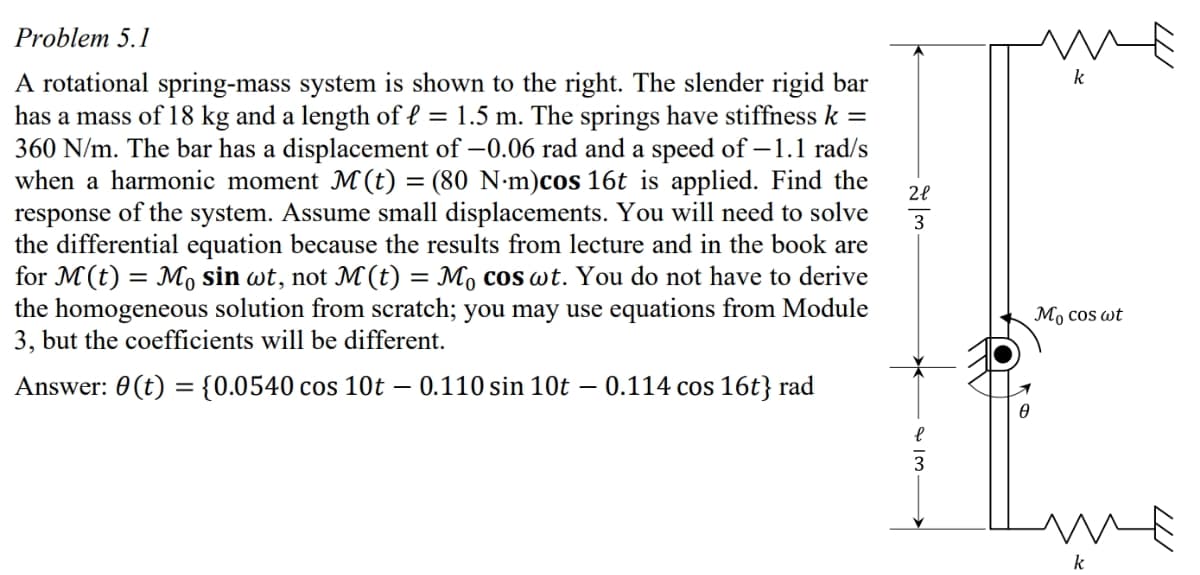A rotational spring-mass system is shown to the right. The slender rigid bar nas a mass of 18 kg and a length of l = 1.5 m. The springs have stiffness k = 360 N/m. The bar has a displacement of -0.06 rad and a speed of -1.1 rad/s when a harmonic moment M(t) = (80 N•m)cos 16t is applied. Find the response of the system. Assume small displacements. You will need to solve he differential equation because the results from lecture and in the book are or M(t) = Mo sin wt, not M (t) = Mo cos wt. You do not have to derive he homogeneous solution from scratch; you may use equations from Module 3, but the coefficients will be different. 2l 3 Mo cos wt Answer: 0(t) ={0.0540 cos 10t 0.110 sin 10t – 0.114 cos 16t} rad
A rotational spring-mass system is shown to the right. The slender rigid bar nas a mass of 18 kg and a length of l = 1.5 m. The springs have stiffness k = 360 N/m. The bar has a displacement of -0.06 rad and a speed of -1.1 rad/s when a harmonic moment M(t) = (80 N•m)cos 16t is applied. Find the response of the system. Assume small displacements. You will need to solve he differential equation because the results from lecture and in the book are or M(t) = Mo sin wt, not M (t) = Mo cos wt. You do not have to derive he homogeneous solution from scratch; you may use equations from Module 3, but the coefficients will be different. 2l 3 Mo cos wt Answer: 0(t) ={0.0540 cos 10t 0.110 sin 10t – 0.114 cos 16t} rad
Elements Of Electromagnetics
7th Edition
ISBN:9780190698614
Author:Sadiku, Matthew N. O.
Publisher:Sadiku, Matthew N. O.
ChapterMA: Math Assessment
Section: Chapter Questions
Problem 1.1MA
Related questions
Question

Transcribed Image Text:Problem 5.1
A rotational spring-mass system is shown to the right. The slender rigid bar
has a mass of 18 kg and a length of { = 1.5 m. The springs have stiffness k =
360 N/m. The bar has a displacement of –0.06 rad and a speed of –1.1 rad/s
when a harmonic moment M (t) = (80 N·m)cos 16t is applied. Find the
response of the system. Assume small displacements. You will need to solve
the differential equation because the results from lecture and in the book are
for M(t) = M sin wt, not M (t) = Mo cos wt. You do not have to derive
the homogeneous solution from scratch; you may use equations from Module
3, but the coefficients will be different.
k
-
3
Мо cos ot
Answer: 0 (t) = {0.0540 cos 10t – 0.110 sin 10t
0.114 cos 16t} rad
k
Expert Solution
This question has been solved!
Explore an expertly crafted, step-by-step solution for a thorough understanding of key concepts.
Step by step
Solved in 2 steps with 1 images

Knowledge Booster
Learn more about
Need a deep-dive on the concept behind this application? Look no further. Learn more about this topic, mechanical-engineering and related others by exploring similar questions and additional content below.Recommended textbooks for you

Elements Of Electromagnetics
Mechanical Engineering
ISBN:
9780190698614
Author:
Sadiku, Matthew N. O.
Publisher:
Oxford University Press

Mechanics of Materials (10th Edition)
Mechanical Engineering
ISBN:
9780134319650
Author:
Russell C. Hibbeler
Publisher:
PEARSON

Thermodynamics: An Engineering Approach
Mechanical Engineering
ISBN:
9781259822674
Author:
Yunus A. Cengel Dr., Michael A. Boles
Publisher:
McGraw-Hill Education

Elements Of Electromagnetics
Mechanical Engineering
ISBN:
9780190698614
Author:
Sadiku, Matthew N. O.
Publisher:
Oxford University Press

Mechanics of Materials (10th Edition)
Mechanical Engineering
ISBN:
9780134319650
Author:
Russell C. Hibbeler
Publisher:
PEARSON

Thermodynamics: An Engineering Approach
Mechanical Engineering
ISBN:
9781259822674
Author:
Yunus A. Cengel Dr., Michael A. Boles
Publisher:
McGraw-Hill Education

Control Systems Engineering
Mechanical Engineering
ISBN:
9781118170519
Author:
Norman S. Nise
Publisher:
WILEY

Mechanics of Materials (MindTap Course List)
Mechanical Engineering
ISBN:
9781337093347
Author:
Barry J. Goodno, James M. Gere
Publisher:
Cengage Learning

Engineering Mechanics: Statics
Mechanical Engineering
ISBN:
9781118807330
Author:
James L. Meriam, L. G. Kraige, J. N. Bolton
Publisher:
WILEY